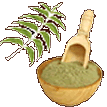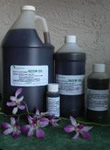FUNGICIDE USE

Instead of using copper, sulphur, or even
systemic treatments, biological neem oil is used on fruits, nuts,
vegetables, herbs, spices, roses, houseplants, flowers, trees, and
shrubs. And it is specially indicated on vineyards against mildew,
who attacks grapes plants, not only as a prevention, but also as an
effective curative treatment.
Neem Oil is an effective fungicide for the
prevention and control of various fungal diseases including powdery
mildew, black spot, downy mildew, anthracnose, rust, leaf spot,
botrytis, needle rust, scab and flower, twig and tip blight, and
alternaria.
ECOLOGICAL GARDENING
Agricultural Research, June, 1994 by Hank Becker
"...in numerous tests, a spray of 1-percent neem
oil in water "stopped 95 to 100 percent of the powdery mildew on
hydrangeas, lilacs, and phlox."
A single spray application was sufficient to
protect these ornamentals from infection. Repeated applications at
7- to 14-day intervals as the plants grew provided disease
protection without any plant damage. On plants where mildew had
begun to develop, "it was arrested, providing control comparable to
each of three chemical fungicides."
Powdery mildew, which also attacks crepe myrtles
and roses, causes leaves to turn white. Preliminary results indicate
the oil will arrest and control the fungus that plagues these
popular ornamentals, especially in humid zones.
 This research, begun in cooperation with former ARS entomologist
Hiram Larew, also demonstrated that neem oil can reduce damage
caused by various pests, including spider mites.
This research, begun in cooperation with former ARS entomologist
Hiram Larew, also demonstrated that neem oil can reduce damage
caused by various pests, including spider mites.
"In preliminary tests, a 2-percent spray of neem
seed oil applied directly to spider mite eggs resulted in an
87-percent mortality".
Research at USDA on plant-derived natural
pesticides, such as nicotine, dates back to the 1920's. Beginning in
1975, extraction products from neem seeds were evaluated for their
insect-killing properties. Many insect pests may be affected by
Azadirachtin including aphids, beetles, caterpillars, lace bugs,
leafhoppers, leafminers, mealybugs, psyllids, thrips and whiteflies.
PEST MANAGEMENT
Neem seeds and leaves contain many compounds
which are useful for pest control. Unlike chemical insecticides,
neem compounds work on the insect’s hormonal system, not on the
digestive or nervous system and therefore doe not lead to
development of resistance in future generations. These compounds
belong to a general class of natural products called ‘limonoids’.
The liminoids present in neem make it a harmless and effective
insecticides, pesticide, nematicide, fungicide etc. The most
significant liminoids found in neem with proven ability to block
insect growth are: azadirachtin, salanin, meliantriol and nimbin.
Azadirachtin is currently considered as neem’s main agent for
controlling insects. ‘It appears to cause 90% of the effect on most
pests. It does not kill insects – at least not immediately – instead
it both repels and disrupts their growth and reproduction. Research
over the past years has shown that it is the most potent growth
regulator and feeding deterrent ever assayed. It will repel or
reduce the feeding of many species of pest insects as well as some
nematodes. In fact, it is so potent that a mere trace of its
presence prevents some insects from even touching plants.’
 Certain hormones are necessary for growth and development of
insects. These hormones control the process of metamorphosis as the
insects pass from larva to pupa to adult. Azadirachtin blocks those
parts of the insect’s brain that produce these vital hormones. As a
result, insects are unable to molt. It is through these subtle
hormonal effects that this important compound of neem breaks the
life cycle of insects. The insect populations decline drastically as
they become unable to reproduce.
Certain hormones are necessary for growth and development of
insects. These hormones control the process of metamorphosis as the
insects pass from larva to pupa to adult. Azadirachtin blocks those
parts of the insect’s brain that produce these vital hormones. As a
result, insects are unable to molt. It is through these subtle
hormonal effects that this important compound of neem breaks the
life cycle of insects. The insect populations decline drastically as
they become unable to reproduce.
Meliantriol and salannin act as powerful
antifeedants. Nimbin as well as nimbidin (another neem component)
have antiviral property.
Blocking the larvae from molting is considered to
be neem’s most important quality which can be used to eliminate many
pest species. Neem products are harmless to most insect eaters,
humans and other mammals, except certain marine life like crabs,
lobsters, fishes and tadpoles.
In spite of high selectivity, neem derivatives affect ca. 400 to 500
species of insects belonging to Blattodea, Caelifers, Dermaptera,
Diptera, Ensifera, Hetroptera, Hymenoptera, Isoptera, Lepidoptera,
Phasmida, Phthiraptera, Siphonoptera and Thysanoptera, one species
of ostracad, several species of mites, and nematodes and even
noxious snails and fungi, including aflatoxin-producing Aspergillus
flavus.
|














 Neem oil is a botanical pesticide made from an extract of the plant
Azadirachta indica. Since it doesn't strongly affect humans,
mammals, or beneficial bugs, farmers use neem oil as an insecticide
and miticide to keep away pests like aphids and white flies. Neem
oil even protects crops from fungal infections such as mildew and
rust. People use insecticide with neem oil to repel mosquitoes and
lice.
Neem oil is a botanical pesticide made from an extract of the plant
Azadirachta indica. Since it doesn't strongly affect humans,
mammals, or beneficial bugs, farmers use neem oil as an insecticide
and miticide to keep away pests like aphids and white flies. Neem
oil even protects crops from fungal infections such as mildew and
rust. People use insecticide with neem oil to repel mosquitoes and
lice.

 Certain hormones are necessary for growth and development of
insects. These hormones control the process of metamorphosis as the
insects pass from larva to pupa to adult. Azadirachtin blocks those
parts of the insect’s brain that produce these vital hormones. As a
result, insects are unable to molt. It is through these subtle
hormonal effects that this important compound of neem breaks the
life cycle of insects. The insect populations decline drastically as
they become unable to reproduce.
Certain hormones are necessary for growth and development of
insects. These hormones control the process of metamorphosis as the
insects pass from larva to pupa to adult. Azadirachtin blocks those
parts of the insect’s brain that produce these vital hormones. As a
result, insects are unable to molt. It is through these subtle
hormonal effects that this important compound of neem breaks the
life cycle of insects. The insect populations decline drastically as
they become unable to reproduce.